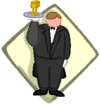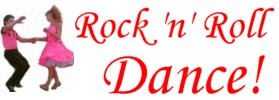Alcohol vs Rock n Roll
00/00/0000
Category: general
The effect of alcohol vs tea-totalling on Rock n Roll dance
Rock n Roll dance is no sinking ship but in South Australia at least, it could be headed for a watery grave. Alcohol is a problem.
Publican after publican has lost patience with the 'dancing crowd' due to their drinking habits. It isn't that Rock 'n' Rollers drink too much, it's the opposite problem. They drink too little!
In Adelaide we are fortunate to have quite a few public bars with dance floors and a Rock n Roll band playing. Usually, there's no cover charge, because dancers are disinclined to pay them. But if we don't drink, how does a venue operator make profits?

"Drink, Sir?"
"No thanks, I don't drink and dance!"
Rock 'n' Roll dancing and alcohol simply don't mix. Most songs we dance to clip along at around 100 beats per minute. Since most of the moves we make (spins, turns, cuddles etc.) take up one whole bar of four beats, they each take roughly two and a half seconds. That's pretty fast dancing when your arms and legs make the number and variety of moves that Rock n Roll requires. At that speed, an intoxicated dancer would be in serious danger of causing injuring to them self, to their partner or other dancers around them. The excessive strength that many people inject into the performance of these moves presents a hazard in the first place. Additional loss of inhibition and poor movement control due to alcohol makes things worse.
Alcohol vs water
Most of the Rock n Rollers I know, including myself, are big drinkers of water or soft drinks. My partner and I frequently dance for a solid hour if a band plays a long set. Our dance style is thirsty work and a sizeable swig of cool water is usually needed after a good work-out. In Adelaide, licensed venues are required by law to provide customers with water but have not been inclined to charge for it. Some sell bottled spring water but operators have been angry disgusted to see Rock 'n' Roll dancers bring their own bottled water onto the premises. In other instances dancers have been miserly enough to purchase a bottle of spring water from the bar, then when it was empty, take it to the public toilet where they re-filled it from a tap!
Behaviour such as this has earned Rock n Roll dancers a bad name in certain circles. They have been branded cheapskates. This is unfair to many of them who do spend a reasonable amount of money on drinks when they socialise.
There is another factor here that needs considering. In Adelaide, most hotels in which the bars and dance venues are located have around forty gaming machines, generating considerable revenue for their owners. It is often the money from the poker machines that pays for the bands. However, publicans argue that while patrons are occupied with dancing they are not playing the machines. That is a fair comment, although it doesn't take into account all possibilities. Some of the dancers do play the poker machines during band breaks.
Publicans have begun progressively replacing Rock n Roll bands with those who play mainly 'nineties 'drinking music'. They argue that for every one dollar spent by a dancer, a drinker spends four. It's easy enough to see their point of view, although the gaming barons in South Australia have acquired vast fortunes even without profits from alcohol.
Rock n Roll dancing has held its own admirably over the years, long outlasting the popularity of the music that spawned it. That hasn't occurred for no reason. It is a great fitness activity and it's good, wholesome entertainment. Being highly visible, since it can be performed to a large range of modern music. It takes place in a lot of locations.
Regular dancers tend to be fit, happy and smiling. They are among the lucky people who have found something in life which they love to do that is inexpensive and freely available. It is, of course, up to dancers to be responsible and diligent in ensuring that they pay their way.
In a world where obesity, drug and alcohol abuse, lack of fitness, mental disturbance, drink driving, where hatred and self-possession are highly prevalent it would be a shame to witness the demise of such a socially responsible activity.
That would be especially so if it was pushed into a grave in favour of profits from alcohol.
First published 2005 by Gareth Eastwood
